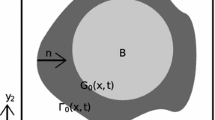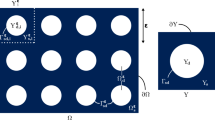Abstract
This paper focuses on heterogeneous soil conductivities and on the impact their resolution has on a solution of the piezometric head equation: owing to spatial variations of the conductivity, the flow properties at larger scales differ from those found for experiments performed at smaller scales. The method of coarse graining is proposed in order to upscale the piezometric head equation on arbitrary intermediate scales. At intermediate scales large scale fluctuations of the conductivities are resolved, whereas small scale fluctuations are smoothed by a partialy spatial filtering procedure. The filtering procedure is performed in Fourier space with the aid of a low-frequency cut-off function. We derive the partially upscaled head equations. In these equations, the impact of the small scale variability is modeled by scale dependent effective conductivities which are determined by additional differential equations. Explicit results for the scale dependent conductivity values are presented in lowest order perturbation theory. The perturbation theory contributions are summed up with using a renormalisation group analysis yielding explicit results for the effective conductivity in isotropic media. Therefore, the results are also valid for highly heterogeneous media. The results are compared with numerical simulations performed by Dykaar and Kitanidis (1992). The method of coarse graining combined by a renormalisation group analysis offers a tool to derive exact and explicit expressions for resolution dependent conductivity values. It is, e.g., relevant for the interpretation of measurement data on different scales and for reduction of grid-block resolution in numerical modeling.
Similar content being viewed by others
References
R. Ababou, D. McLaughlin, L.W. Gelhar and A. Thompson, Numerical simulation of threedimensional saturated flow in randomly heterogeneous porous media, Transport Porous Media 4 (1989) 549-565.
M. Abramowitz and I.A. Stegun, Handbook of Mathematical Functions (Dover, New York, 1965).
F.G. Alabert, Constraining description of randomly heterogeneous reservoirs to head data: A Monte Carlo study, SPE paper 19600 presented at the 64th Annual Meeting, Soc. of Petr. Engrg., San Antonio, TX (1989).
S. Attinger, J. Eberhard and N. Neuss, Filtering procedures for flow in heterogeneous porous media: Numerical results, Comput. Visualization Sci. 5(2) (2002) 67-72.
R. Beckie, A comparison of methods to determine measurement support volumes, Water Resour. Res. 37(4) (2001) 925-936.
R. Beckie, A.A. Aldama and E.F. Wood, Modeling the large-scale dynamics of saturated groundwater flow using spatial filtereing theory: 1. Theoretical development and 2. Numerical evaluation, Water Resour. Res. 32(5) (1996) 1269-1280 and 1281-1288.
G. Dagan, Flow and Transport on Porous Formations (Springer, Berlin, 1989).
D.S. Dean, I.T. Drummond and R.R. Horgan, Perturbation theory for effective diffusivity in random gradient flows, J. Phys. A Math. Gen. 28 (1995) 1235-1242.
D.S. Dean, I.T. Drummond and R.R. Horgan, Effective diffiusivity in non-ositropic gradient flows, J. Phys. A Math. Gen. 28 (1995) 6013-6025.
A. Desbarats, Spatial averaging of transmissivity in heterogeneous fields with flow toward a well, Water Resour. Res. 28(3) (1992) 757-767.
C.V. Deutsch and A.G. Journel, Integrating well test derived effective absolute conductivities in geostatistical reservoir modeling, in: Stochastic Modeling and Geostatistics: Principles, Methods and Case Studies, eds. J. Yarus and R. Chambers, AAPG Computer Applications in Geology, No. 3 (Amer. Assoc. of Petrol. Geol., Tulsa, 1994) pp. 131-142.
L.J. Durlovsky, Representation of grid block hydraulic conductivity in coarse scale models of randomly heterogeneous porous media, Water Resour. Res. 28(7) (1992) 1791-1800.
B.B. Dykaar and P.K. Kitanidis, Determination of the effective hydraulic conductivity for heterogeneous porous media using a numerical spectral approach, 1. Methods and 2. Results, Water Resour. Res. 28(4) (1992) 1155-1178.
Y. Efendiev, L.J. Durlofsky and S.H. Lee, Modeling of subgrid effects in coarse-scale simulations of transport in heterogeneous porous media, Water Resour. Res. 36(8) (2000) 2031-2041.
Y. Efendiev, T.Y. Hou and X. Wu, Convergence of a nonconforming multiscale finite element method, SIAM J. Numer. Anal. 37(3) (2000) 888-910.
L. Gelhar, Effects of hydrolic conductivity variations n groundwater flow, in: Proc. of the 2nd Internat. Syposium on Stochastic Hydraulics, International Association for Hydraulic Research, Lund, Sweden (Water Resources Publications, Fort Collins, 1977) pp. 409-428.
L. Gelhar, Stochastic Subsurface Hydrology (Prentice-Hall, Englewood Cliffs, NJ, 1993).
C.F. Harvey, Interpreting parameter estimates obtained from slug tests in heterogeneous aquifers,M.S. thesis, Appl. Earth Science Department, Stanford University, Stanford (1992).
T.Y. Hou and X. Wu, A mulitscale finite element method for elliptic problems in composite materials and porous media, J. Comput. Phys. 134 (1997) 169-189.
T.Y.H. Hou, X. Wu and Z. Cai, Convergence of a multiscale finite element method for elliptic problems with rapidly oscillating coefficients, Math. Comp. 68(227) (1999) 913-943.
P. Indelman, A. Fiori and G. Dagan, Steady flow toward wells in heterogeneous formations: Mean head and equivalent conductivity, Water Resour. Res. 32(7) (1996) 1975-1983.
A. Journel and C. Huijbregts, Mining Geostatistics (Academic Press, New York, 1978).
W.D. McComb, Physics of Fluid Turbulence (Clarendon Press, Oxford, 1990).
S. Neuman and S. Orr, Prediction of steady state flow in nonuniform geologic media by conditional moments: Exact nonlocal formalism, effective conductivities and weak approximation, Water Resour. Res. 29(2) (1993) 341-364.
S. Nilsen and M. Espendal, Wavelet upscaling based on piecewise bilinear approximation of the hydraulic conductivity field, Transport in Porous Media (1996).
D.S. Oliver, The averaging process in hydraulic conductivity estimation from well-test data, SPE Form Eval. 5 (1990) 319-324.
G. Papanicolaou and S.R.S. Varadhan, Boundary value problems with rapidly oszillating random coefficients, Colloquia Mathematica Societatis Janos Bolyai (1979).
F. Stauffer, Estimates of dispersion parameters by geostatistical methods–Laboratory and field applications, in: Internat. Symposium–Contaminant Transport in Groundwater, eds. H.E. Kobus and W. Kinzelbach, Stuttgart, 4-6 April 1989.
M.J.L. Robin, A.L. Gutjahr, E.A. Sudicky and J.L. Wilson, Cross-correlated random field generation with the direct Fourier transform method, Water Resour. Res. 29(7) (1993) 2385-2397.
Y. Rubin, A. Sun, R. Maxwell and A. Bellin, The concept of block-effective macrodispersivity and a unifierd approach for grid-scale and plume-scale-dependent transport, J. Fluid Mech. 395 (1999) 161-180.
X. Sanchez-Vila, Radially convergent flow in heterogeneous porous media, Water Resour. Res. 33(7) (1997) 1633-1641.
X. Sanchez-Vila, C. Axness and J. Carrera, Upscaling transmissivity under radially convergent flow in heterogeneous media, Water Resour. Res. 35(3) (1999) 613-621.
E. Vanmarcke, Random Fields: Analysis and Synthesis (MIT Press, Cambridge, MA, 1983).
S. Whitaker, The Method of Volume Averaging, Theory and Applications of Transport in Porous Media, Vol. 13 (Kluwer Academic, 1999).
Author information
Authors and Affiliations
Rights and permissions
About this article
Cite this article
Attinger, S. Generalized Coarse Graining Procedures for Flow in Porous Media. Computational Geosciences 7, 253–273 (2003). https://doi.org/10.1023/B:COMG.0000005243.73381.e3
Issue Date:
DOI: https://doi.org/10.1023/B:COMG.0000005243.73381.e3




